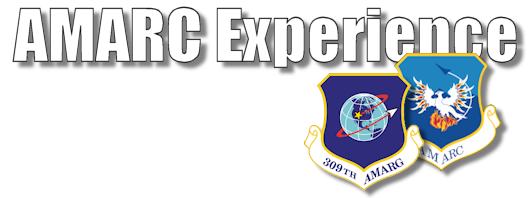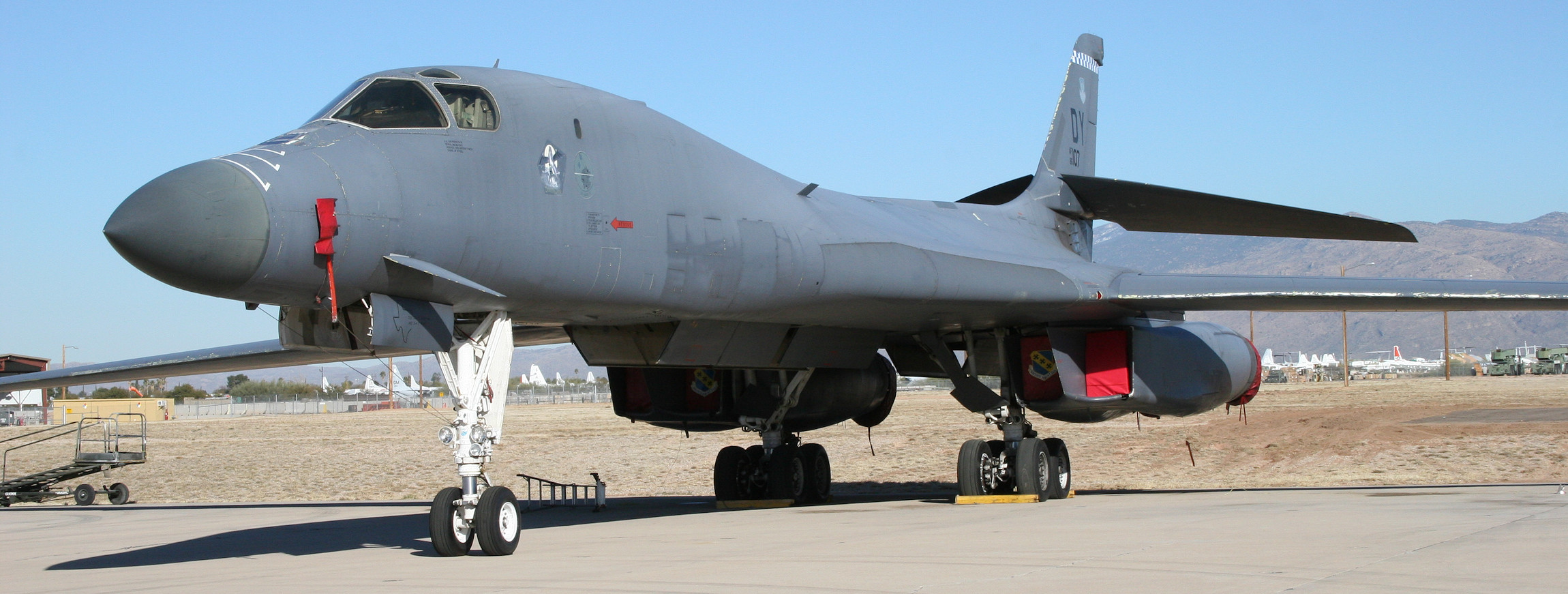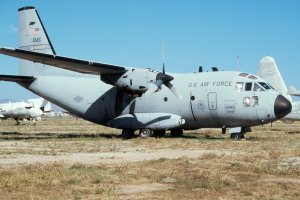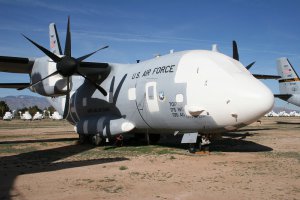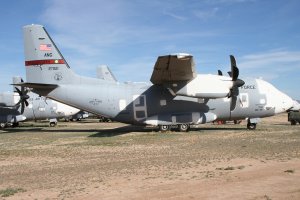In 1962 the Italian company Fiat published a proposal for a new medium sized V/STOL transport aircraft. The aircraft was being aimed at fulfilling a NATO requirement to support V/STOL fighters while they were widely dispersed during wartime conditions. The design included the use of Rolls Royce Dart engines and a twin tailboom which would accomodate up to eight Rolls-Royce RB-162 lift engines to help achieve the V/STOL capability required. No contract was immediately forthcoming and it wasn't until 1968 that the Italian Air Force became interested in the new aircraft, albeit in a substantailly redesigned configuration. An order was placed for two prototypes which were powered by General Electric T64 engines in place of the Rolls Royce Darts, a single tail instead of the twin boom and omitting the eight lift engines.
On July 18th, 1970 the first prototype G.222 took to the air and after successful testing the Italian Air Force placed an order with Aeritalia (which by now Fiat was part of) for 44 of the type. Over the next twenty years the type went on to become reasonably successful with a number of sales to foreign military operators including Argentina, United Arab Emirates, Libya, Somalia, Thailand and Venezuela.
In 1990, after modification work by Chrysler Corporation to incorporate new radio communication sets, ten G.222s entered service with the U.S. Air Force as a Rapid-Response Intra-Theater Airlifter (RRITA) and with the designation C-27A Spartan. The Air Force requirement was for a tactical transport aircraft that could operate in rough fields of approximately 500 meters and the C-27A was considered the ideal aircraft. They were assigned to the 24th Wing based at Howard AFB, Panama. where they provided support to Southern Command humanitarian, counter-drug and peace keeping missions in Central and South America.
Alenia C-27A Spartan 90-0170. © Phil Kovaric.
Alenia C-27A Spartan 90-0172. © Phil Kovaric.
Alenia C-27A Spartan 90-0173. © Phil Kovaric.
Alenia C-27A Spartan 91-0107. © Phil Kovaric.
Over the next 9 years the C-27s were kept very busy operating from mainly remote areas with only dirt or grass landing strips. They took part in a number of notable operations including the relief effort following Hurricane Mitch, which devastated several Central American countries including Honduras, Guatemala and Nicaragua in 1998. Another high profile operation was in support of Military Observation Mission Ecuador Peru or MOMEP, which was a peacekeeping mission to help settle a border dispute between Ecuador and Peru. The C-27As mission included the carriage of supplies and personnel from Howard AFB to the short dirt strip at Patuca, Ecuador twice weekly. The nearest airfield that could be used by a C-130 Hercules was more than 4 hours away by road!
The first three C-27As were retired to AMARC during 1997, the rest of the fleet arriving in January 1999. Despite the successes and the capabilities of the aircraft, the Air Force found the maintenance and parts expensive compared to other operational types and due to the reduction in funding decided to cancel the program.
For two aircraft, 90-0171 and 91-0106, the retirement did not last long as in July of 1999 they were regenerated to the U.S. State Department Bureau of International Narcotics and Law Enforcement Affairs for operation from Patrick AFB, FL. in their counter-narotics operations back in South America. These aircraft were later joined by 90-0104 in October 1999, and then 90-0174 and 91-0103 during October 2000 and March 2001.
In October 2008 90-0170 was regenerated to the Air Force Research Laboratory (AFRL) based in Eglin AFB, FL. The aircraft was used to trial the mounting of 30mm and 40mm guns in a feasibility study to develop the AC-27J gunship which was envisaged to replace the ageing AC-130 Hercules gunship platform. The trial was put on hold in 2009 due to cuts to the 2010 budget.
Retirement from U.S. State Department
During March 2013 three of the five C-27As which had been previously re-generated at AMARC for the U.S. State Department were retired once again to AMARG. These were followed by a fourth (91-0104) during May 2013. A full summary of AMARC/AMARG movements for these aircraft can be found below;
First Alenia C-27J Spartan Retires to AMARG
09-27021 is the first of 21 C-27J which are to be retired at the end of fiscal year 2013. This aircraft was operated by the 186th Air Refueling Wing which is based at Key Field AGS, Meridian, MS. which serves as the ANG C-27J Flying Training Unit. As well as providing training capability the unit's aircraft have also served in Afghanistan and provided airlift service during humanitarian operations.
These retirments are part of the Department of Defense's attempts at reducing its spending by $487 billion over the next 10 years. Other C-27J will be retired from Maryland, Michigan, Ohio Air National Guards.
Due to the age and capabilities of the C-27J its stay at AMARG may well be a short one with suggestions that the aircraft will find a future with operators. The National Defense Authorization Act allocated seven for the Forest Service for firefighting activities (more information can be seen here) and it has been reported that the Coast Guard and other Agencies may receive a share of the remaining fleet.
C-27J Spartans to be re-generated
The U.S. Coast Guard are to receive fourteen of the retired C-27J Spartans under an intra-service transfer between the Air Force and the Department of Homeland Security. It is planned that they will enter service within one year.
The C-27Js will join the USCG's fleet of eighteen Airbus North America HC-144A Ocean Sentry (a version of the twin turboprop powered CASA/IPTN CN235-300M) maritime patrol aircraft currently on strength. The 36 HC-144As which were to be acquired by the USCG are likely to be reduced in number due to the adoption of the C-27J.
Upon receiving the aircraft they will receive improvements to their operational capabilities with the addition of surface-search radars, electro-optical sensors and mission suites.
It has also been reported that the Special Operations Command is to receive the remaining seven C-27J.
Alenia C-27J Spartan 07-21011. This aircraft, which was devoid of all unit markings except for plain U.S. Army lettering on the fuselage, was operated by L-3 Communication/Vertex and was based at Robins AFB, GA. © Phil Kovaric.
Alenia C-27J Spartan 08-27017. Before retirement this aircraft was operated by the 135th Airlift Squadron/135th Airlift Group of the MD Air National Guard and was based at Warfield ANGB. © Phil Kovaric.
Alenia C-27J Spartan 09-27018. Before retirement this aircraft was operated by the 135th Airlift Squadron/135th Airlift Group of the MD Air National Guard and was based at Warfield ANGB. © Phil Kovaric
Alenia C-27J Spartan 09-27020. Before retirement this aircraft was operated by the 153rd Airlift Squadron/186th Airlift Wing of the MS Air National Guard and was based at Key Field, Meridian. © Phil Kovaric.
Alenia C-27J Spartan 09-27021. Before retirement this aircraft was operated by the 153rd Airlift Squadron/186th Airlift Wing of the MS Air National Guard and was based at Key Field, Meridian. © Phil Kovaric.
Alenia C-27J Spartan 10-27023. This aircraft, which is devoid of all unit markings except for plain U.S. Army lettering on the fuselage, was operated by L-3 Communication/Vertex and was based at Robins AFB, GA. © Phil Kovaric.
Specifications
General Specifications
| Powerplant | 2 × General Electric T64-GE-P4D turboprop, 3,400 shp (2,535 kW) each |
| Length | 74 ft 5½ in (22.70 m) |
| Wingspan | 94 ft 2 in (28.70 m) |
| Height | 32 ft 1¾ in (9.80 m) |
| Wing area | 893 ft² (82.0 m²) |
| Empty weight | 32,165 lb (14,590 kg) |
| Max. takeoff weight | 61,730 lb (28,000 kg) |
| Crew | Four - commander, co-pilot, radio-operator/flight engineer on flightdeck, loadmaster |
| Capacity | 19,840 lb (9,000 kg) of cargo, 53 troops or 36 litters |
Performance
| Maximum speed | 336 mph (291 knots, 540 km/h) at 15,000 ft (4,575 m) |
| Cruise speed | 273 mph (237 knots, 439 km/h) at 19,700 ft (6,000 m) |
| Range | 852 miles (740 nmi, 1,371 km) at max payload |
| Ferry range | 2,879 miles (2,500 nmi, 4,633 km) |
| Service ceiling | 25,000 ft (7,620 m) |
| Rate of climb | 1,705 ft/min (8.7 m/s) |

